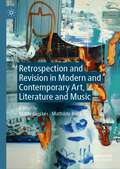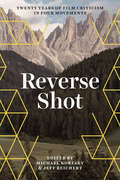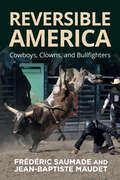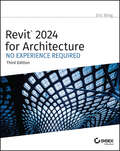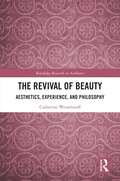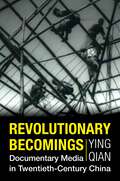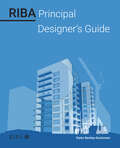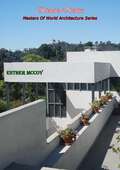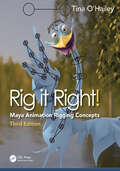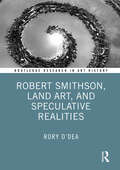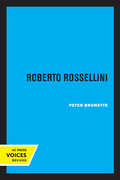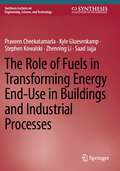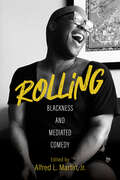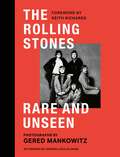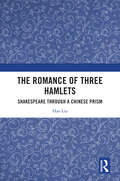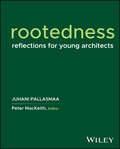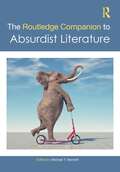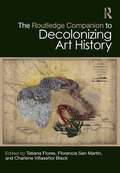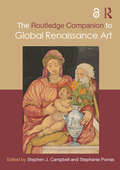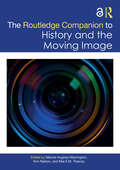- Table View
- List View
Retrospection and Revision in Modern and Contemporary Art, Literature and Music
by Mette Gieskes Mathilde RozaThis interdisciplinary book investigates the various ways in which North American and European modern and contemporary artists, authors, and musicians have returned to earlier works of their own, engaging in inventive revivals and transformations of the past in the present. The book is distinctive in its focus on such revisits, as well as in the diversity of art forms under review: in addition to visual art, the book explores fiction, poetry, literary criticism, film, rock music, and philosophy. This scope, together with the time-span covered in the book, from the 1850s to the twenty-first century, allows for a broad view on retrospection and revision. The case studies presented here offer a multifaceted exploration of the widely different goals to which practitioners of the arts have made retrospection and revision functional against the background of cultural, social, political, and personal forces.
Reverse Shot: Twenty Years of Film Criticism in Four Movements
by Michael KoreskyFor twenty years, Reverse Shot, a journal for film criticism and the house publication of New York’s Museum of the Moving Image, has been a home for movie lovers to find incisive, intelligent writings from a diverse group of the best critics working today.To celebrate the publication's run, MoMI has published this special anniversary anthology, which collects central pieces from the journal’s beginnings up through the latest releases. Broken into four chronological movements, this volume captures not only the films and filmmakers that Reverse Shot’s writers have championed and wrestled over but also tells a story of cinema’s progress and change over the first two decades of the 21st century.More than just for the many longtime readers of Reverse Shot, this collection is an essential reference for the past, present, and future of the moving image and a gift for anyone who cares about films and serious writings about them.“This New York-based publication has remained not only a beacon for quality film writing but also, in so many cases, the domain for the internet’s best piece on a given film. ... Digging into the earliest writings here affirms a site quickly setting an Olympian standard for online movie analysis, pole-vaulting even over many esteemed print publications with less space to play with on the page ... Any one essay gives you a taste of the levels of insight routinely put to bear by its shifting stable of contributors, including Nick Pinkerton, Genevieve Yue, Eric Hynes and Devika Girish.” —Sight & Sound magazine, March 2024
Reversible America: Cowboys, Clowns, and Bullfighters
by Frédéric Saumade Jean-Baptiste MaudetRodeo, cattle ranching, and bullfighting converge in the arenas of race, gender, and ethics in Reversible America. In Southwestern California, these sports manifest in spectacular expressions of transcultural interactions that continue to develop through border crossings. Using an interdisciplinary scope, this unique look into the subculture negotiates the paradoxes and connections between the popular American performances, Iberian bullfighting, and Native American hunting methods, along with the relationship between human and non-human beings, and systems of value across borders.
Revit 2024 for Architecture: No Experience Required
by Eric WingThe latest and most authoritative version of the popular step-by-step tutorial for Revit Architecture The newly revised third edition of Revit 2024 for Architecture: No Experience Required is the latest update to the market-leading, real-world guide for learning and building with Revit—the powerful and sophisticated Building Information Modeling (BIM) software used by professionals around the world. This popular, user-friendly book teaches you the Revit interface and helps you understand the foundational concepts and features of the software. You’ll learn to design, document, and present a 3D BIM project with a continuous, step-by-step tutorial that guides you through every phase of the project: from placing walls, doors, windows, structural elements, dimensions, and text, to generating documentation, advanced detailing, site grading, construction scheduling, material takeoffs, and more. In addition, this book helps you prepare for the Autodesk Revit Architecture Certification Exam. Throughout the book, you will find helpful insights directly related to the exam. The last two chapters are dedicated entirely to the exam with a practice test at the end of the book. You’ll also: Learn each phase of designing, documenting, and presenting a four-story office building using a simple yet engaging continuous tutorial Follow the tutorial sequentially or jump to any chapter by downloading the project files from the Sybex website Use the start-to-finish tutorial project as a reference for your own real-world projects and to develop a powerful Revit skillset Gain thorough knowledge of Revit’s essential concepts and features to make the move from 2D drafting to 3D building information modeling Get up to speed with advanced features, including new coverage of advanced walls, families, sites, topography, and moreThe Autodesk Revit 2024 for Architecture: No Experience Required, 3rd Edition, is the go-to guide for professionals and students seeking to learn Revit’s essential functions quickly and effectively.
The Revival of Beauty: Aesthetics, Experience, and Philosophy (Routledge Research in Aesthetics)
by Catherine WesselinoffThis book provides original descriptive accounts of two schools of thought in the philosophy of beauty: the 20th-century “Anti-Aesthetic” movement and the 21st-century “Beauty Revival” movement. It also includes a positive defence of beauty as a lived experience extrapolated from Beauty-Revival position.Beauty was traditionally understood in the broadest sense as a notion that engages our sense perception and embraces everything evoked by that perception, including mental products and affective states. This book constructs and places in parallel with one another the Anti-Aesthetic and Beauty-Revival movements. In the author’s view, Anti-Aestheticism is devoted to a decisive negation of beauty—denying its importance as a philosophical notion and its significance as a lived experience. It suggests that beauty is a merely sensual experience, which can be used, at best, as a distraction from justice and, at worst, as an instrument of evil. Alternatively, the Beauty-Revival movement advances arguments for beauty as an experience that extends primarily to sensual experience, but which also calls forth mental products and cognitive and affective states evoked by that experience. After reconstructing these two positions, the author elaborates on the notion of beauty as a lived experience through three key moments which occur in the process of our experiencing beautiful objects. These moments are (a) the conditions that constitute an experience of beauty, (b) the attitudinal features most likely to lead to the experience of beauty, and (c) the results of the experience of beauty.The Revival of Beauty will be of interest to scholars and advanced students working in aesthetics, history of philosophy, and art history.
The Revolution Takes Form: Art and the Barricade in Nineteenth-Century France
by Jordan Marc RoseDuring the French Revolution of 1830, insurgents raised some four thousand barricades. Afterward, lithographs of the street fighting flowed from the presses, creating the barricade’s first imagery. This book documents the changing political valence of the revolutionary ideals associated with the barricade in France from 1830 to 1852.The Revolution Takes Form coordinates the political reality of the barricade with the divergent ways in which its image gave shape to the period’s conceptions of class, revolution, and urban space. Engaging the instability of the barricade, art historian Jordan Marc Rose focuses on five politically charged works of art: Eugène Delacroix’s La Liberté guidant le peuple, Honoré Daumier’s Rue Transnonain, le 15 avril 1834 and L’Émeute, Auguste Préault’s Tuerie, and Ernest Meissonier’s Souvenir de guerre civile. The history of these artworks illuminates how such revolutionary insurrections were characterized—along with the conceptions of “the people” they mobilized. Foregrounding a trajectory of disillusionment, growing class tensions, and ultimately open conflict between bourgeois liberals and the proletariat, Rose both explains why the barricade became a compelling subject for pictorial reflection and accounts for its emergence as the period’s most poignant and meaningful symbol of revolution.Original and convincing, this book will appeal to students and scholars of art history and, in particular, of the history of the French Revolution.
Revolutionary Becomings: Documentary Media in Twentieth-Century China (Investigating Visible Evidence: New Challenges for Documentary)
by Ying QianFrom the toppling of the Qing Empire in 1911 to the political campaigns and mass protests in the Mao and post-Mao eras, revolutionary upheavals characterized China’s twentieth century. In Revolutionary Becomings¸ Ying Qian studies documentary film as an “eventful medium” deeply embedded in these upheavals and as a prism to investigate the entwined histories of media and China’s revolutionary movements.With meticulous historical excavation and attention to intermedial practices and transnational linkages, Qian discusses how early media practitioners at the turn of the twentieth century intermingled with rival politicians and warlords as well as civic and business organizations. She reveals the foundational role documentary media played in the Chinese Communist Revolution as a bridge between Marxist theories and Chinese historical conditions. In considering the years after the Communist Party came to power, Qian traces the dialectical relationships between media practice, political relationality, and revolutionary epistemology from production campaigns during the Great Leap Forward to the “class struggles” during the Cultural Revolution and the reorganization of society in the post-Mao decade. Exploring a wide range of previously uninvestigated works and intervening in key debates in documentary studies and film and media history, Revolutionary Becomings provides a groundbreaking assessment of the significance of media to the historical unfolding and actualization of revolutionary movements.
RIBA Principal Designer's Guide
by Dieter Bentley-GockmannThe RIBA Principal Designer Guide, a companion guide to the RIBA Health and Safety Guide, provides architects with an essential understanding of the Principal Designer duties under the Construction (Design and Management) Regulations and Building Safety Act Dutyholder Regulations. To ensure chartered architects are reaching a high standard of knowledge, the RIBA has introduced an online test based on a comprehensive curriculum to test for competency. The must-have content considers details of the relevant statutory duties, guidance regarding the implications of those duties for project delivery and examples of documents, templates and schedules that Principal Designers could use to manage, track and demonstrate compliance with the duties. This guide also includes guidance on the competence requirements for Principal Designers with content mapped against BSI Flex 8670 and PAS 8671 that enables readers to demonstrate their competence.
Richard Neutra: Masters Of World Architecture Series
by Esther McCoyDiscover the visionary work and enduring legacy of one of modern architecture's most influential figures in Esther McCoy's "Richard Neutra: Masters Of World Architecture Series." This meticulously researched and richly illustrated book offers an in-depth exploration of Richard Neutra's life, philosophy, and groundbreaking contributions to 20th-century architecture.Esther McCoy, a renowned architectural historian and critic, provides a comprehensive account of Neutra's career, from his early years in Vienna to his pivotal role in shaping the architectural landscape of Southern California and beyond. Through engaging narrative and detailed analysis, McCoy highlights Neutra's innovative approach to design, characterized by his commitment to integrating nature, technology, and human needs.The book delves into Neutra's most iconic projects, including the Lovell Health House, the Kaufmann Desert House, and the Case Study Houses, showcasing his mastery of form, function, and environmental harmony. McCoy examines how Neutra's work responded to the challenges of modern living, emphasizing his use of open plans, extensive glazing, and seamless indoor-outdoor transitions to create spaces that promote health and well-being.Rich with photographs, sketches, and architectural drawings, "Richard Neutra: Masters Of World Architecture Series" provides readers with a visual feast and a deeper understanding of Neutra's design principles and aesthetic vision. McCoy also explores Neutra's collaborations with other prominent architects and his influence on subsequent generations of designers.This book is an essential read for students of architecture, practicing architects, and anyone interested in the evolution of modern design. Esther McCoy's authoritative and engaging writing brings Neutra's work to life, offering readers a comprehensive and inspiring portrait of a true master of world architecture.
Rig it Right!: Maya Animation Rigging Concepts
by Tina O'HaileyRig It Right! breaks down rigging so that you can achieve a fundamental understanding of the concept. The author will get you up and rigging with step-by-step tutorials covering multiple animation control types, connection methods, interactive skinning, BlendShapes, edgeloops, and joint placement, to name a few. The concept of a biped is explored as a human compared to a bird character allowing you to see that a biped is a biped and how to problem solve for the limbs at hand. Rig It Right! will take you to a more advanced level where you will learn how to create stretchy rigs with invisible control systems and use that to create your own types of rigs.This highly anticipated Third Edition features updated chapters and images, including new chapters on modeling with proper edgeloop (Rule #1!), how to Rig It Right then Rig it Fast with parallel processing, and new helpful scripts for evaluating your rig with the profiler tools.Key Features Hone your skills every step of the way with short tutorials and editable rigs that accompany each chapter (17+ rigs!!) Read "Tina’s 10 Rules of Rigging" and build the foundational knowledge needed to successfully rig your characters New content: Edgeloops for Good Deformation and Rigging for a Parallel World New scripts for evaluating your rigs’ performance Access the Support Materials and expand your newfound knowledge with editable rigs, exercises, and videos that elaborate on techniques covered in the book
Robert Smithson, Land Art, and Speculative Realities (Routledge Research in Art History)
by Rory O'DeaThis book explores the ways Robert Smithson’s art revealed and defamiliarized the constructs of rational reality in order to allow radically speculative alternatives to emerge. In this way, his art is conceived as a true fiction that eradicates a false reality. By tracing the web of correspondences between Smithson and science fictional, speculative and mystical modes of thought, Rory O’Dea explores the aesthetic encounters engendered by his art as a means to warp the contours of reality and loosen the boundaries of being human. Given the current and impending catastrophes of the Anthropocene, which represents the ever-expanding planetary shadow cast by humanism, the possibility of being other-than-human posited by Smithson’s art is a matter of urgent concern. The book will be of interest to scholars working in art history, contemporary art, American studies and environmental humanities.
Roberto Rossellini
by Peter BrunetteThis is the first full-length study in any language of the most significant film director of Italian Neorealism. Peter Brunette combines close analyses of Roberto Rossellini's formal and narrative style with a thorough account of his position in the political and cultural landscape of postwar Italy. More than forty films are explored, including Open City, Paisan, Voyage to Italy, The Rise to Power of Louis XIV, and films made in the director's later years that documented crucial epochs in human history. Brunette's book is based on eight years of research, during which he interviewed members of the director's family as well as Rossellini himself. Brunette also draws on an enormous body of European and American criticism and discusses the various intellectual debates spawned by the director's work. This landmark study is both a comprehensive introduction to one of the most influential practitioners of the contemporary cinema and a boldly original discussion of Italian Neorealism. This title is part of UC Press's Voices Revived program, which commemorates University of California Press's mission to seek out and cultivate the brightest minds and give them voice, reach, and impact. Drawing on a backlist dating to 1893, Voices Revived makes high-quality, peer-reviewed scholarship accessible once again using print-on-demand technology. This title was originally published in 1996.
The Role of AI in Bio-Medical Translations’ Research for the Health Care Industry: First International Conference, AIBTR 2023, Nagpur, India, September 23, 2023, Revised Selected Papers (Communications in Computer and Information Science #1987)
by Sivaram Ponnusamy Vibha Rajesh BoraThis book constitutes the revised selected papers of the First International Conference, AIBTR 2023, held in Nagpur, India, during September 22–23, 2023.The 7 full papers included in this volume were carefully reviewed and selected from 37 submissions. The papers contained in this book discuss the application of Artificial Intelligence in Biomedical Engineering for the Health Care industry.
The Role of Fuels in Transforming Energy End-Use in Buildings and Industrial Processes (Synthesis Lectures on Engineering, Science, and Technology)
by Praveen Cheekatamarla Kyle Gluesenkamp Stephen Kowalski Zhenning Li Saad JajjaEnergy-efficient technologies are necessary to lower the carbon footprint for a transition towards clean energy in a sustainable manner. This book examines what role fuels have in the transformation of end-use in buildings and industrial processes. Energy-efficient technologies are necessary to lower the carbon footprint for a transition towards clean energy in a sustainable manner. Efficient utilization of primary energy resources, including renewables, to support the current and future energy needs while targeting grid resiliency, energy, and environmental security at an affordable cost is of significant value. The author analyzes heat pumps, fuel-driven thermal providers, and power systems configurations and looks at the sensitivity of the electrical grid's carbon intensity and tariff towards carbon footprint and energy costs compared with fuel-driven technologies. The role of low-carbon, zero-carbon, and carbon-negative fuels, such as power-to-gas (P2G), power-to-liquid (PtL), hydrogen, and biogas, in conjunction with polygeneration technologies, are discussed. This book also examines two different scenarios focused on the sensitivity of the pace of decarbonization of the electrical grid and fuel supply on operational energy-related carbon emissions.Compares electricity versus fuel as a primary energy sourceExplores the role of fuels in the decarbonization journey Examines the value proposition of currently available energy solutions
Rolling: Blackness and Mediated Comedy (Comedy & Culture)
by Anshare Antoine Gerald R. Butters Jr. Ellen Cleghorne Kelly Cole Phillip Lamarr Cunningham Ken Feil Lisa Guerrero Timothy Havens Felicia D. Henderson Jacqueline Johnson Alfred L. Martin Jr. Scott Poulson-Bryant Mel Stanfill Joshua TrueloveSince slavery, African and African American humor has baffled, intrigued, angered, and entertained the masses.Rolling centers Blackness in comedy, especially on television, and observing that it is often relegated to biopics, slave narratives, and the comedic. But like W. E. B. DuBois's ideas about double consciousness and Racquel Gates's extension of his theories, we know that Blackness resonates for Black viewers in ways often entirely different than for white viewers. Contributors to this volume cover a range of cases representing African American humor across film, television, digital media, and stand-up as Black comic personas try to work within, outside, and around culture, tilling for content. Essays engage with the complex industrial interplay of Blackness, white audiences, and comedy; satire and humor on media platforms; and the production of Blackness within comedy through personal stories and interviews of Black production crew and writers for television comedy.Rolling illuminates the inner workings of Blackness and comedy in media discourse.
The Rolling Stones Rare and Unseen: Foreword by Keith Richards, afterword by Andrew Loog Oldham
by Gered MankowitzFOREWORD BY KEITH RICHARDS'ICONIC... DAZZLING.'-MOJO'Gered was at one with the band. More than that, for that special time, he was in the band.'-ANDREW LOOG OLDHAM'He was a hell of a lot of fun. That's why he was a good photographer.'-MARIANNE FAITHFULLDelve into the unseen archive of iconic photographer Gered Mankowitz as he shares rare and newly discovered images of his time with the Rolling Stones, alongside his most iconic shots.Just a teenager, Mankowitz took some of the best-loved photographs of the Stones in their frantic, formative years. Now for the first time he looks beyond those famous images - unearthing frames that have never been seen before, plus those rarely used.Also featuring Gered's first-hand stories and a host of expert writers on the band and their music - including The Times' chief rock and pop critic Will Hodgkinson, Ben Sisario of the New York Times as well as academics, fashion writers and more - The Rolling Stones Rare and Unseen is a fresh look at the greatest story in rock 'n' roll.AFTERWORD BY ANDREW LOOG OLDHAM
The Rolling Stones Rare and Unseen: Foreword by Keith Richards, afterword by Andrew Loog Oldham
by Gered MankowitzFOREWORD BY KEITH RICHARDS'ICONIC... DAZZLING.'-MOJO'Gered was at one with the band. More than that, for that special time, he was in the band.'-ANDREW LOOG OLDHAM'He was a hell of a lot of fun. That's why he was a good photographer.'-MARIANNE FAITHFULLDelve into the unseen archive of iconic photographer Gered Mankowitz as he shares rare and newly discovered images of his time with the Rolling Stones, alongside his most iconic shots.Just a teenager, Mankowitz took some of the best-loved photographs of the Stones in their frantic, formative years. Now for the first time he looks beyond those famous images - unearthing frames that have never been seen before, plus those rarely used.Also featuring Gered's first-hand stories and a host of expert writers on the band and their music - including The Times' chief rock and pop critic Will Hodgkinson, Ben Sisario of the New York Times as well as academics, fashion writers and more - The Rolling Stones Rare and Unseen is a fresh look at the greatest story in rock 'n' roll.AFTERWORD BY ANDREW LOOG OLDHAM
The Romance of Three Hamlets: Shakespeare through a Chinese Prism
by Hao LiuThrough a metaphorical journey of Shakespeare in traditional Chinese theatre, using three Chinese opera productions of Hamlet as signposts, the book discusses the relationship between Shakespeare and Chinese theatrical traditions.A brief discussion of the Yue-opera Hamlet looks back at the role of Shakespeare in the Chinese discourse of renaissance and re-evaluation of traditions since the early twentieth century. A detailed analysis of the Peking-opera Hamlet shows what is lost and what is gained in the negotiation between Shakespeare and Chinese theatrical traditions, and why. The third Hamlet is an experimental Kun-opera production, leading to a discussion of the potential for Shakespeare and Chinese theatrical traditions to join hands and reach new depths of artistic expression.The book will attract researchers, students, and enthusiasts of Shakespeare, cross-cultural Shakespearean recreation, Chinese theatrical traditions, and comparative literature.
Rootedness: Reflections for Young Architects
by Juhani Pallasmaarootedness Discover the insights and lessons of architect Juhani Pallasmaa In Rootedness: Reflections for Young Architects, Juhani Pallasmaa delivers an insightful and expansive collection of his most compelling ideas into architecture’s position among arts and culture. Pallasmaa speaks to architecture students and young professionals, discussing each topic with sincerity and openness, suggesting what can be learned from areas of culture beyond the boundaries of familiar professional disciplines. He outlines the growing need for an architecture based in self-awareness, reconnection to the environment, and a sense of ethical responsibility. Each essay in Rootedness was initially conceived and presented as an educational lecture and has been carefully edited with clarifications, refinements, and valuable expansions. Accompanying sketches by the author emphasize the personal and intimate nature of the essays. The book also includes: Explorations of perception, creative practice, and the need for an ethical stance Thoughts, meditations, and challenges emerging from the author’s search for identity and purpose in his architectural work A wealth of references within the essays, as well as recommendations for books and films from which readers may draw further inspiration Designed for students of architecture at any age, Rootedness: Reflections for Young Architects will also inspire professional architects, designers, and those in other creative professions.
The Routledge Companion to Absurdist Literature (Routledge Literature Companions)
by Michael Y. BennettThe Routledge Companion to Absurdist Literature is the first authoritative and definitive edited collection on absurdist literature. As a field-defining volume, the editor and the contributors are world leaders in this ever-exciting genre that includes some of the most important and influential writers of the twentieth century, including Samuel Beckett, Harold Pinter, Edward Albee, Eugene Ionesco, Jean Genet, and Albert Camus. Ever puzzling and always refusing to be pinned down, this book does not attempt to define absurdist literature, but attempts to examine its major and minor players. As such, the field is indirectly defined by examining its constituent writers. Not only investigating the so-called “Theatre of the Absurd,” this volume wades deeply into absurdist fiction and absurdist poetry, expanding much of our previous sense of what constitutes absurdist literature. Furthermore, long overdue, approximately one-third of the book is devoted to marginalized writers: black, Latin/x, female, LGBTQ+, and non-Western voices.
The Routledge Companion to Decolonizing Art History (Routledge Art History and Visual Studies Companions)
by Tatiana Flores Florencia San Martín Charlene Villaseñor BlackThis companion is the first global, comprehensive text to explicate, theorize, and propose decolonial methodologies for art historians, museum professionals, artists, and other visual culture scholars, teachers, and practitioners. Art history as a discipline and its corollary institutions—the museum, the art market—are not only products of colonial legacies but active agents in the consolidation of empire and the construction of the West. The Routledge Companion to Decolonizing Art History joins the growing critical discourse around the decolonial through an assessment of how art history may be rethought and mobilized in the service of justice—racial, gender, social, environmental, restorative, and more. This book draws attention to the work of artists, art historians, and scholars in related fields who have been engaging with disrupting master narratives and forging new directions, often within a hostile academy or an indifferent art world. The volume unpacks the assumptions projected onto objects of art and visual culture and the discourse that contains them. It equally addresses the manifold complexities around representation as visual and discursive praxis through a range of epistemologies and metaphors originated outside or against the logic of modernity. This companion is organized into four thematic sections: Being and Doing, Learning and Listening, Sensing and Seeing, and Living and Loving. The book will be of interest to scholars working in art history, visual culture, museum studies, race and ethnic studies, cultural studies, disability studies, and women’s, gender, and sexuality studies.
The Routledge Companion to Decolonizing Art History (Routledge Art History and Visual Studies Companions)
by Tatiana Flores Florencia San Martín Charlene Villaseñor BlackThis companion is the first global, comprehensive text to explicate, theorize, and propose decolonial methodologies for art historians, museum professionals, artists, and other visual culture scholars, teachers, and practitioners.Art history as a discipline and its corollary institutions - the museum, the art market - are not only products of colonial legacies but active agents in the consolidation of empire and the construction of the West. The Routledge Companion to Decolonizing Art History joins the growing critical discourse around the decolonial through an assessment of how art history may be rethought and mobilized in the service of justice - racial, gender, social, environmental, restorative, and more. This book draws attention to the work of artists, art historians, and scholars in related fields who have been engaging with disrupting master narratives and forging new directions, often within a hostile academy or an indifferent art world. The volume unpacks the assumptions projected onto objects of art and visual culture and the discourse that contains them. It equally addresses the manifold complexities around representation as visual and discursive praxis through a range of epistemologies and metaphors originated outside or against the logic of modernity. This companion is organized into four thematic sections: Being and Doing, Learning and Listening, Sensing and Seeing, and Living and Loving.The book will be of interest to scholars working in art history, visual culture, museum studies, race and ethnic studies, cultural studies, disability studies, and women’s, gender, and sexuality studies.
The Routledge Companion to Global Renaissance Art (Routledge Art History and Visual Studies Companions)
by Stephen J. Campbell Stephanie PorrasThis companion examines the global Renaissance through object-based case studies of artistic production from Africa, Asia, the Americas, and Europe in the early modern period.The international group of contributors take an art historical approach characterized by close analysis of form and meaning as well as function, and a focus on questions of crosscultural dialogue and adaptation. Seeking to de-emphasize the traditional focus on Europe, this book is a critical guide to the literature and the state of the field. Chapters outline new questions and agendas while pushing beyond familiar material. Main themes include workshops, the migrations of artists, objects, technologies, diplomatic gifts, imperial ideologies, ethnicity and indigeneity, sacred spaces and image cults, as well as engaging with the open questions of "the Renaissance" and "the global."This will be a useful and important resource for researchers and students alike and will be of interest to scholars working in art history, visual culture, material culture, and Renaissance studies.The Open Access version of this book, available at www.taylorfrancis.com, has been made available under a Creative Commons [Attribution-Non Commercial-No Derivatives (CC-BY-NC-ND)] 4.0 license
The Routledge Companion to History and the Moving Image (Routledge Companions)
by Marnie Hughes-Warrington Kim Nelson Treacey, Mia E.M.The Routledge Companion to History and the Moving Image takes an interdisciplinary approach to understanding history in moving images. It engages this popular and dynamic field that has evolved rapidly from film and television to digital streaming into the age of user-created content. The volume addresses moving image history through a theoretical lens; modes and genres; representation, race, and identity; and evolving forms and formats. It brings together a range of scholars from across the globe who specialize in film and media studies, cultural studies, history, philosophy of history, and education. Together, the chapters provide a necessary contemporary analysis that covers new developments and questions that arise from the shift to digital screen culture. The book examines technological and ethical concerns stemming from today’s media landscape, but it also considers the artificial construction of the boundaries between professional expertise and amateur production. Each contributor’s unique approach highlights the necessity of engaging with moving images for the academic discipline of history. The collection, written for a global audience, offers accessible discussions of historiography and a compelling resource for advanced undergraduates and postgraduates in history, film and media studies, and communications.
The Routledge Companion to History and the Moving Image (Routledge Companions)
by Marnie Hughes-Warrington Kim Nelson Treacey, Mia E.M.The Routledge Companion to History and the Moving Image takes an interdisciplinary approach to understanding history in moving images. It engages this popular and dynamic field that has evolved rapidly from film and television to digital streaming into the age of user-created content.The volume addresses moving image history through a theoretical lens; modes and genres; representation, race, and identity; and evolving forms and formats. It brings together a range of scholars from across the globe who specialize in film and media studies, cultural studies, history, philosophy of history, and education. Together, the chapters provide a necessary contemporary analysis that covers new developments and questions that arise from the shift to digital screen culture. The book examines technological and ethical concerns stemming from today’s media landscape, but it also considers the artificial construction of the boundaries between professional expertise and amateur production. Each contributor’s unique approach highlights the necessity of engaging with moving images for the academic discipline of history.The collection, written for a global audience, offers accessible discussions of historiography and a compelling resource for advanced undergraduates and postgraduates in history, film and media studies, and communications.Both Chapter 17 and the Afterword of this book are freely available as downloadable Open Access PDFs at http://www.taylorfrancis.com under a Creative Commons [Attribution-Non Commercial-No Derivatives (CC-BY-NC-ND)] 4.0 license.
